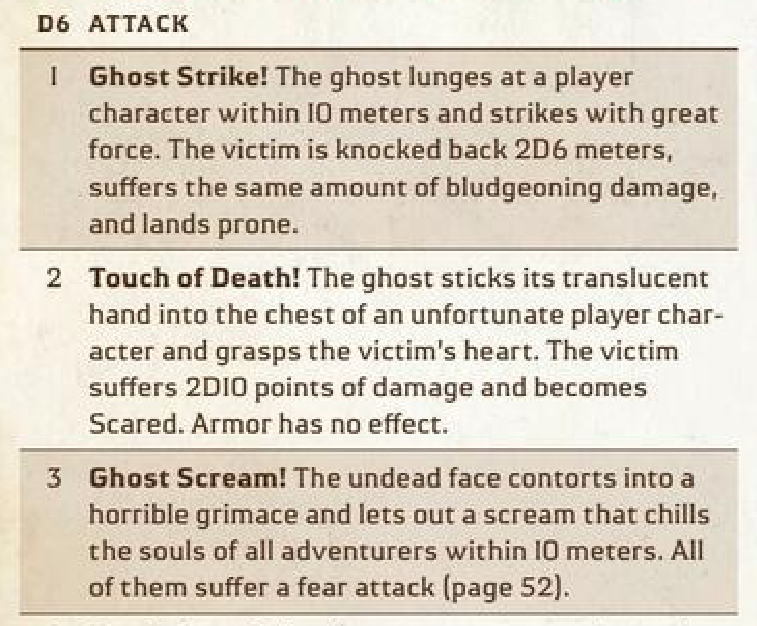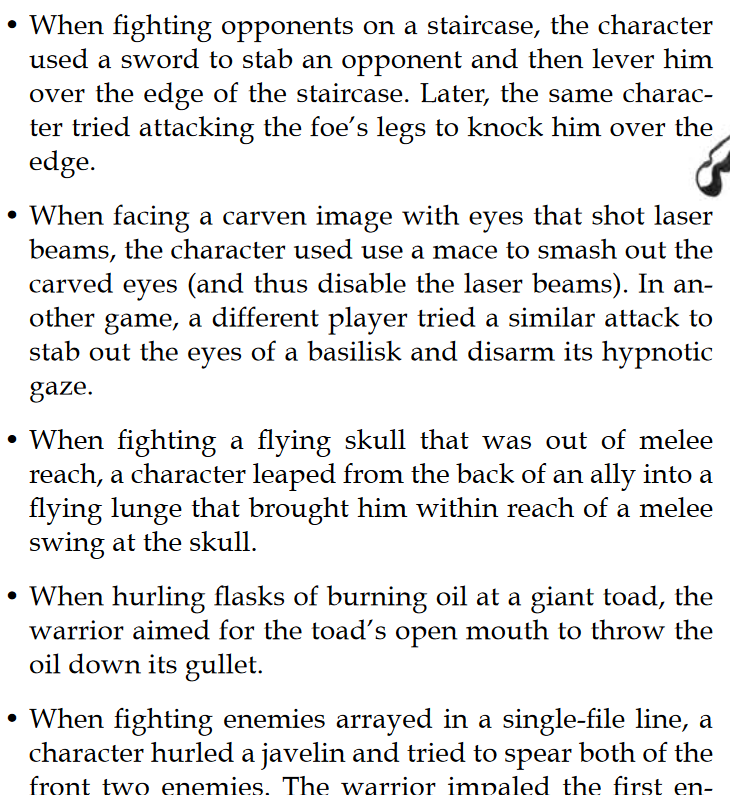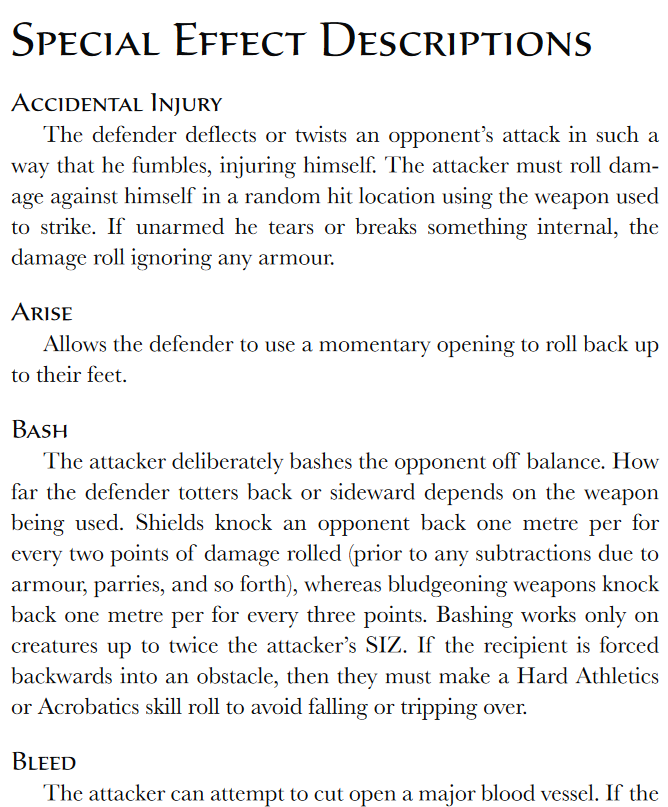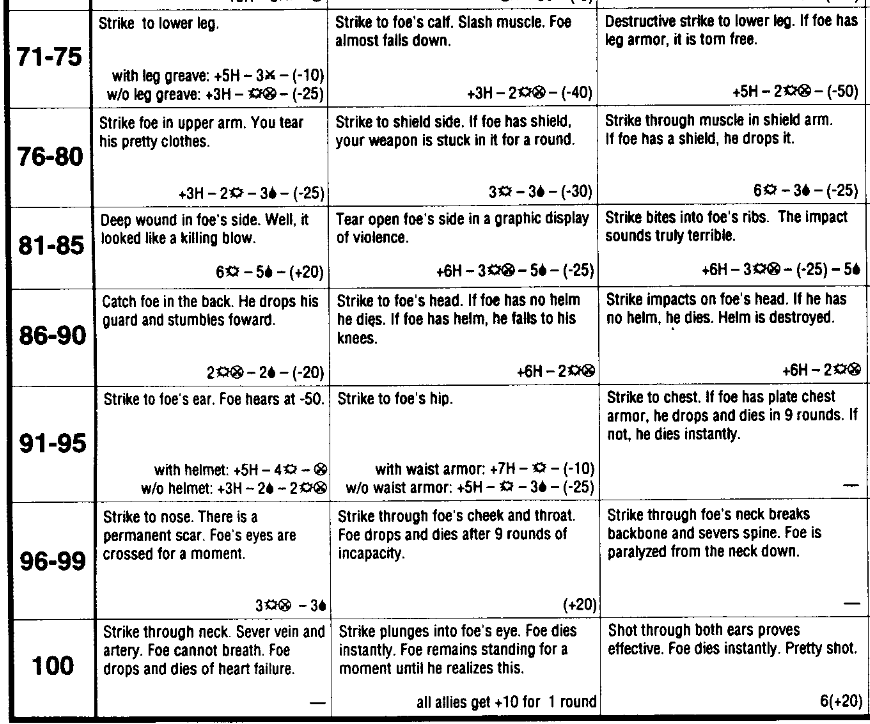I asked on Reddit for lovers of tabletop role-playing games to let me know what combat mechanics they loved. It’s a long thread that veers off in multiple directions so I narrowed down the repeating themes here.
What’s interesting is how many of the same topics came up again and again. Yes there were people who liked the exact opposite of what other people liked but I was surprised how many mechanics got repeatedly mentioned.
This list is far from complete and not in any particular order but it does have some cool ideas.
When I first started this list I didn’t see much of a pattern but by the time I got to the end of making this list it was really obvious and the insights I gained about what most people want in the rpg combat surprised me…
1: The Same Core Mechanics As The Rest Of The Game
Many players didn’t want combat to be its own separate mini game. Having said that, some players did want that.
I think the two main sentiments here are, first, not having to learn a whole different system to run combat. Second, many players liked a seamless transition from other play into combat.
2: Player Facing Rolls
Instead of the GM rolling attacks for monsters or opponents many players preferred for players to roll a defense roll instead. Advantages cited were avoiding players seeing the GM as an adversary, increased player agency, less work for the GM, and total transparency in all rolls during combat (there’s no GM fudging when the players make all the combat rolls).
A couple of GMs mentioned that they LIKED making monster attack rolls so while popular this wasn’t universally popular. Some GMs want to kill things!
3: Opposed Rolls
Wanting opposed rolls in combat was mentioned multiple times. Just one example of opposed rolls would be Warhammer Fantasy Role Play where attack and defense actions (such as dodging or parrying) are resolved using opposed rolls, with the attacker rolling against the defender’s weapon or dodge skill.
4: Roll Randomly To See What Type Of Attack A Monster Makes
This is used in Dragonbane and Forbidden Lands (both Free League products). In Dragonbane all monster attacks hit automatically and those monster attack rolls can be terrifying.
Let me give you an example. When a ghost attacks in Dragonbane the GM rolls a d6 table to see which of six different attacks the monster makes. These are the first 3 attacks on the table…

If you haven’t already acted in the combat round you may have the chance to dodge some monster attacks (a player facing roll which is a mechanic also mentioned in this post), but usually you just have to take the attack and deal with the consequences.
This is terrifying fun that makes monsters FEEL like monsters. It’s also great for solo play. Monsters doing cool and scary things was important. One player mentioned liking lengendary monster attacks in Dungeons and Dragons 5e.
Monsters hitting most of the time leads into the next mechanic…
5: Every Attack Hits
More games have this mechanic and it has gained significant popularity. In Cairn and Into The Odd there is no ‘to hit’ roll. You just roll for damage.
This speeds up combat considerably, eliminates the problem where players who miss feel like they haven’t done anything during a combat round, and makes combat feel dangerous and deadly.
The Nimble rules hack of Dungeons & Dragons also rolls for damage instead of having a ‘to hit’ roll then a damage roll. In Nimble you only miss on a critical fail which is a one on an assigned damage die that you roll.
Baron de Ropp of the YouTube channel Dungeon Masterpiece once said that ‘once you’ve played without to hit rolls you won’t go back.’ Or something along those lines. This is not a newspaper article.
Many players who’ve used roll for damage systems that don’t have to hit rolls feel the same or at the very least appreciate the speed and simplicity of these systems.
6: Static Damage:
Another less mentioned but repeating theme was static damage where if an attack succeeds you don’t roll for damage, attacks of the same type always do the same amount of damage. In some cases a ‘critical success’ would do double damage.
Looking at the overview, the major trend was players seemed to prefer making one roll for an attack and for every attack they made to have some kind of meaning (as opposed to making a to hit roll that might miss, then making a damage roll that might do very little damage).
7: Mighty Deeds In Dungeon Crawl Classics
Mighty Deeds of Arms in Dungeon Crawl Classics lets martial characters (like Warriors and Dwarves) perform cool cinematic actions during combat. These Mighty Deeds let players do stunts such like disarming, tripping, pushing, or landing precise strikes. You roll a special Deed Die, which adds to both the attack roll and damage, while also determining if the deed succeeds. If the Deed Die rolls a 3 or higher, it succeeds and wild stuff happens.
There’s no fixed list of Mighty Deeds. Players invent their own stunts based on the situation. The Deed Die grows as the character levels up (it’s a step dice system), making higher-level warriors capable of performing even more impressive feats. This mechanic encourages bold, heroic combat and adds excitement to encounters, with every roll potentially leading to dramatic and unpredictable results. Whether a warrior knocks an enemy off balance, disarms a foe, or creates an advantage for allies, Mighty Deeds make combat more narrative-driven and epic in nature.
Here are some live play examples of Mighty Deeds of Arms from Dungeon Crawl Classics…

8: Special Effects In Mythras
The more successful an attack is in Mythras, the more spectacular or effective the effect you can choose. Mythras has a huge list of these cool effects from stabbing an opponent and leaving the blade there to continue doing damage and making actions difficult for the stabbed opponent or compelling them to surrender.
Here is a tiny sample of some of the Mythras special effects…

9: Knockback & Stunts
Multiple games have some kind of ‘Knockback’ mechanic. In Savage Worlds, for example, when a character takes a particularly strong hit (such as from an explosive spell or powerful melee attack), they may be knocked back a number of inches equal to the damage roll divided by four. The distance can push them into obstacles, off ledges, or into other hazards, making knockback potentially deadly and very cool.
In Knave when you roll a critical success you can choose to do double damage or you can choose to perform a ‘stunt’ like pushing an opponent back, pushing them off something, charging through them, etc. Whatever you can think of that’s cool. The GM adjudicates if you need to make a stat roll etc. to see if the stunt succeeds.
10: Tests In Savage Worlds
Only mentioned once but they are cool. You might throw sand in a foe’s eyes (using Athletics), insult them to throw off their concentration (using a Taunt), or fake them out with a feint (Fighting or Athletics).
If they succeed these tests can leave your foe distracted or vulnerable making their actions or attacks less effective or making an attack against them more likely to succeed.
11: The Rule Of Cool
Many people said in different ways that they wanted to do more in combat than just deal damage. They wanted the choice of doing cool things like those mighty deeds, special effects, knockbacks and stunts.
Let me break away from the reddit thread for a minute and give a suggestion that might be helpful for people looking for a way to get more cool actions into their combat.
In a similar way to Dungeon Crawl Classic’s Mighty Deeds dice, mechanics like ‘Luck Dice’ or ‘hero dice’ from DM Scotty used in the hugely fun game EZD6 can make the Rule of Cool come alive. Put simply you get a small pool of d6 dice that you can use to increase any roll.
Professor Dungeonmaster uses Deathbringer Dice in his D&D hack Deathbringer as an alternative to giving players feats and special powers. Because these d6 add on dice can be used on nearly any player roll, it gives players a huge amount of freedom to attempt anything they think is cool.
Bob World Builder explains the use of luck dice in a fun way in this video:
12: Brutal Critical Hit Tables
Along the same lines as Mythras, critical hit tables from Rolemaster were mentioned (those are some brutal critical hits!) Several players also mentioned that they liked hit locations for attacks in their combat systems.
Players looking for more crunchy, gritty play, or more cool, realistic feeling effects often appreciate these.
Here’s a small sample of the puncture critical hit table from Rolemaster…

13: Card Based Initiative
Several people posted about liking card based initiative. Examples of card based initiative include Savage Worlds, Forbidden Lands, and Dragonbane where you and your opponents draw cards from a deck to see who goes first. In Dragonbane you can choose to wait if you get the opportunity to go first.
This adds an interesting element of strategy without taking up the time other initiative systems do. Cards are turned over once a player’s action is complete which makes keeping track of who has taken a turn very easy.
In Dragonbane, some players and some monsters get to draw multiple cards which accounts for players who are faster in combat and monsters with multiple attacks.
Card based initiative is probably popular because it maintains the strategic possibilities of initiative while making initiative simple and easy to run.
In this video Justin from the YouTube channel Books, Bricks & Boards uses the Dragonbane initiative system while playing solo. He also demonstrates the Dragonbane monster attacks mentioned earlier in this post…
14: Pathfinder 2e’s Three Action System
Many people love the three actions you get in pathfinder and the one reaction. Personally it gives me a headache, but it’s probably less of a headache than the action economy in fifth edition Dungeons & Dragons.
If you want a more crunchy action economy that takes everything into account that 3 action economy looks pretty good. It’s interesting to note that many of the players describing play using the 3 action economy described how it made doing a combination of cool actions easier and more intuitive.
15: Escalation Die From The 13th Age
This mechanic ensures that combat doesn’t drag on endlessly. The Escalation Die is a six-sided die (d6) that starts at 0 at the beginning of combat and increases by 1 each round, up to a maximum of 6.
Starting on the second round, players can add the current value of the Escalation Die to their attack rolls. So, as the battle continues, the players’ chances of hitting enemies improve.
16: Lethality Rules in Delta Green
At least two people posted about Delta Green’s lethality rules. In Delta Green weapons with Lethality can instantly kill a target if you roll low enough.
Insights:
The vast majority of the combat mechanics people loved facilitated at least one of two goals:
1: Doing cool stuff during combat. Either amazing stunts, or mighty deeds, or tests, or special effects, or the trend to more cool, gritty results like the critical hits in Rolemaster or rolling for Monster attacks in Dragonbane and Forbidden Lands.
2: Making combat go faster. Dumping the ‘to hit’ roll and just rolling for damage, static damage which eliminates the damage roll, player facing rolls, consistent core mechanics, and card based initiative, all speed up combat encounters. The escalation die and lethality rolls makes sure combat doesn’t go on too long.
I think that’s a great lesson for game designers, module designers, GMs and players because everyone involved in gaming can help improve both of those.
I’d like to thank all the wonderful people who responded to this reddit post and gave us such wonderful insights.
I also apologize if I didn’t mention something you shared in the post. I found everyone’s contributions incredibly valuable but I couldn’t cover them all.
Leave a Reply